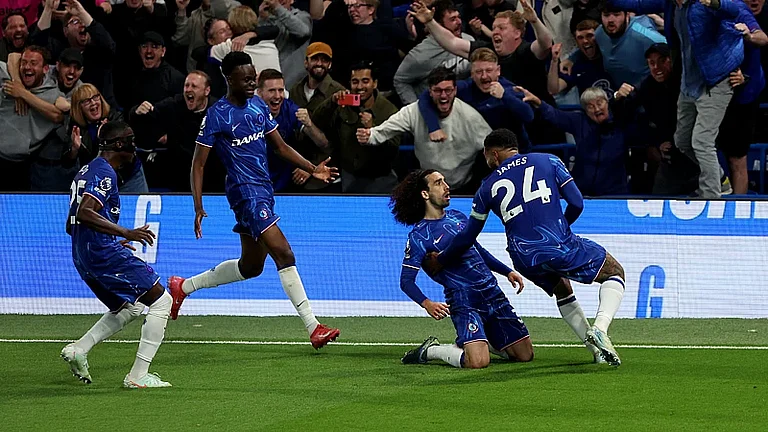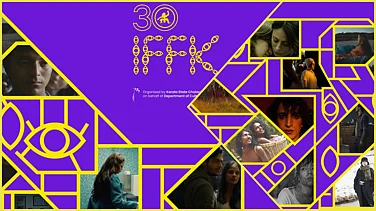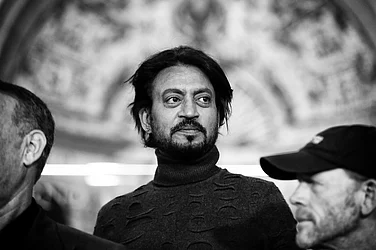Shortly after Indian independence, in November 1947 to be precise, it was at Srinagar’s famous Lal Chowk that the then prime minister Jawaharlal Nehru unfurled the tricolour and promised Kashmiris their right to choose their political future. The square has ever since been the backdrop for several token political gestures as well as some raging conflicts and controversies. The big moment of Haider, Vishal Bhardwaj’s Hamlet set in 1995 Kashmir, is the invocation of this Lal Chowk plebiscite and the forgotten promise of demilitarisation and self-determination. In the film’s most rousing scene, you have Haider grieving his father’s death and betrayal by those close to him. Head shaven, noose around his neck, a transistor hanging in front, he blabbers away some uncomfortable truths in his seeming madness. He speaks of Article 370 (that grants special autonomous status to Jammu and Kashmir), of India and Pakistan playing border-border with Kashmir, and rounds it off with—“Hum leke rahenge azadi”. The crowd of curious bystanders, gathered around him, chants in unison and, a whole world away, in a Delhi multiplex, the audience is strained into a deafening, disconcerting silence.
Of course, there are some easy simplifications, some broad brush-strokes and uncalled-for romantic interludes, but what Bhardwaj pulls off with Haider is in using the beautiful but stark, autumnal/wintry landscape to invoke a sense of bleakness and doom, grief and gloom that is Kashmir. The reinterpreted ‘To be or not to be’ soliloquy—“Shaq pe hai yakeen to, yakeen par hai shaq mujhe...Kiska jhooth jhooth hai, kiska sach sach nahin...Jaan loon ki jaan doon, main rahoon ki main nahin”—captures all of Kashmir’s dilemmas. The suffocation, the doubts and suspicions, the obfuscations and complications are as true to the inner world of Hamlet as to the people of Kashmir caught perennially in the midst of insurgency, counter-insurgency, terrorism, politics, local police and the armed forces. As Haider says, “Poora Kashmir ek qaidkhana hai (all of Kashmir is a prison).” Or like his mother Ghazala puts it, the state, like her, is “aadhi bewa, aadhi dulhan (half-widow and half-bride)”.
Bhardwaj’s Haider might be the most discomfiting but certainly not the first Hindi film to take up the issue of Kashmir and talk of the injustices meted out to Kashmiris and denial of self-determination to them. ‘Azadi’ crept up in Aamir Bashir’s (who, incidentally, plays Liyakat/Laertes in Haider) 2010 film Harud but it fell prisoner to the censor board’s whims. The sloganeering had to be muted and graffiti disallowed in the promo of the film. Much before that, Kunal Kohli’s 2006 film Fanaa—despite treating terrorism as some kind of a James Bond-like spy thriller—became a rare Hindi mainstream film to talk of the possibility of a referendum in Kashmir. In the time-honoured tradition of Bollywood, the ‘jehadis’ eventually met their logical end, the universe didn’t really fall apart, but at least the words ‘Azad Kashmir’ were uttered, something that had so far been a no-no in popular cinema, where Kashmir has been nothing more than a pretty backdrop. The more serious explorations have come in the realm of documentaries like Jashn-e-Azaadi and Inshallah Football. Or in off-mainstream movies like Bashir’s Harud, Santosh Sivan’s Tahaan, Onir’s I Am, Piyush Jha’s Sikander and Shoojit Sircar’s Yahaan.
***
Kashmir Down The Ages In Bollywood
- Kashmir Ki Kali (1964) The beautiful Dal Lake, flower-laden shikaras, snow-decked mountains, a coy Kashmiri heroine played by the Bengali Sharmila Tagore, and singing-dancing hero Shammi Kapoor. Kashmir as Bollywood has mostly known it.
- Noorie (1979) The scenic backdrop of Bhaderwah valley and the gorgeous Poonam Dhillon were the highlights of this tragic, yet picturesque, love story
- Henna (1991) Indo-Pak love story of the Indian Hindu hero who strays into the Pakistan side of Kashmir and falls for the light-eyed beauty Henna
- Roja (1992) Newly married Roja moves from Tirunelveli to Srinagar with husband Ravi only to find her world turned upside down when he is kidnapped by terrorists
- Dil Se (1998) Insurgency and resistance in Kashmir feature prominently as the hero chases a beautiful woman, and terrorism, from the Northeast to Kashmir and Ladakh
- Mission Kashmir (2000) A young man gets brainwashed into becoming a terrorist to avenge his innocent family’s death. Eventually sense prevails.
- Jab Tak Hai Jaan (2012) The armyman hero specialises in defusing bombs along Kashmir and Ladakh
***

Tahaan 2008
What explains this limited engagement of Bollywood with Kashmir? “Bollywood is pro-Establishment,” says Bashir. “When it comes to Kashmir, it’s been a fictional engagement, about wayward baddies being reformed and rehabilitated.” Sircar blames it on the ignorance about Kashmir, not just amongst filmmakers but in India at large. “It has become so complex a political situation that even Kashmiris don’t know the way out,” he says. Onir, who set the Megha segment of I Am in Kashmir, says it’s to do with the fact that there is no infrastructure and huge issues of security when it comes to shooting in Kashmir.
When they do take up the Kashmir story therefore, most filmmakers adopt a personal approach. Harud would seem a likely subject for Bashir, who was born and brought up in Srinagar and moved to Delhi for college. But he hadn’t quite planned the film in his head when he set out to make it, he only wanted to focus on the human dimension. “I didn’t want a bigger canvas and scale to lose out on the intimacy,” he says. “Nor did I want to exoticise the kangris and the samovars.” Harud therefore presents Kashmir through the anguished, angry and besieged eyes of Rafiq, an aimless drifter who’s just trying to live in a world where Indian army soldiers, guns and bunkers are as commonplace as the trees and the snow; humiliating searches, hunts and inquiries are a way of life. It is a relentlessly grim, ringside view of embattled lives. A mother perennially searching for her lost elder son and a father on the verge of a mental breakdown.

Harud 2010
Sivan, on the other hand, tackled Kashmir like a fable in Tahaan, a film about the journey of an innocent child and his donkey. “I consciously didn’t want to glorify nor vilify anything or anyone, I wanted to deal in metaphors,” he says. So Tahaan has the missing fathers and the half-widows, but Sivan doesn’t spell it all out, he leaves a lot to be read between the lines. “I didn’t want to make a political speech, I wanted to make a film,” he says.
Onir too wanted his film to be more ‘experiential’ than ‘intellectual’. He built on the experience of his own producer-actor Sanjay Suri, four generations of whose family had lived in Kashmir but who had to move out in 1990. The trigger for the film came when he went back in 2008, 17-and-a-half years after they had been displaced. “It took a lot to go back,” says Suri. “It was like knocking at the door of one’s own house like a stranger.”
Onir went there two or three times with the writer, met the locals, stayed with Muslim families and felt the need to include their story as well. “I wanted to keep it in a sensitive space, make it like a dialogue, an exploration of two different emotional, psychological states,” he says. “It is less about homecoming, more about reuniting, rebridging,” says Suri. So if Juhi Chawla, a Kashmiri Hindu in the film, speaks of loss of home and identity, Manisha Koirala, her Muslim friend who stayed on in strife-torn Kashmir, reminds her that they may have a home and identity, but have lost out on life.

I Am 2010
Sircar based Yahaan purely on a newspaper article about a local Kashmiri girl falling in love with a jawaan on bunker duty at Lal Chowk. “I did show the atrocities, the disappearances. I did talk politics, but it was more about the girl,” he says.
Coming back to Haider, Bhardwaj’s one-sided vision has affronted many—the Kashmiri Pandits and supporters of the Indian army in particular. However, it is this very effort to please all that has become Haider’s undoing. The very army which is shown proclaiming “catch them by the balls, their hearts and minds shall follow” is also shown telling Kashmiris how they have saved them from Kabayilis; another armyman justifies how one man’s torture is another’s investigation. The empty Kashmiri Pandit houses has him say that oustees too should be considered amongst the disappeared. From the provocative, jokey send-up of AFSPA—Chutzpah (both have the same “awaaz aur maane”, sound and meaning)—Bhardwaj puts the onus of a Gandhian, non-violent struggle on the locals a trifle self-righteously and also has a character talk of “Hindustan se azadi” as being “Pakistan se ghulami”. There is also a needlessly smarmy hat tip to the army’s laudatory role in the recent floods. These apart, what stays on in the mind are the uncomfortable truths mainstream cinema rarely ever tackles. “It has sneaked in and caught the imagination,” says Bashir. So while Bang Bang rakes in the crores, let Haider launch a thousand debates.






















